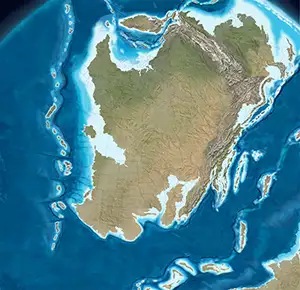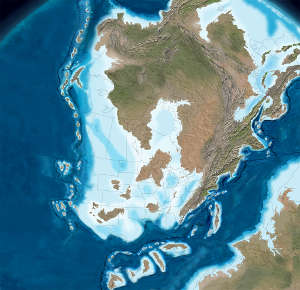The Devonian Period
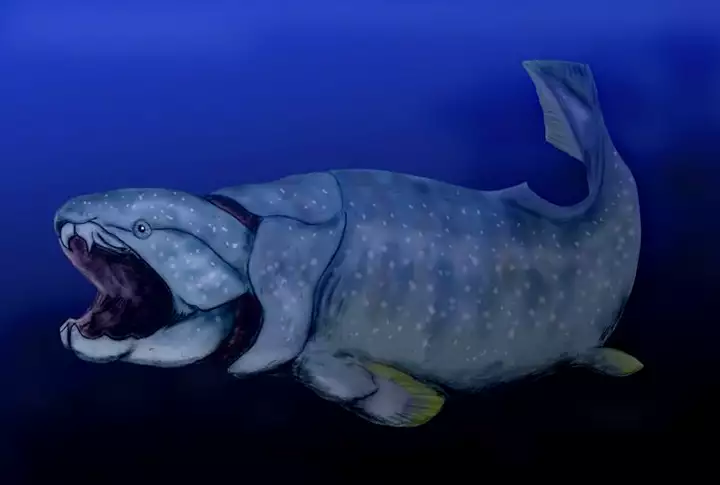
Dunkleosteus: an armored fish from the Devonian
The Devonian Period lasted from about 416 million years ago to about 359 million years ago. The Devonian Period has been called The Age of Fish. The Devonian has been broken into several phases based on fossils of fauna found today, most phases being dated by major extinction events. Then end of the Period is dated by the Hangenberg Event, a time when sea levels were rapidly dropping and global glaciation was advancing. The event has been marked as a layer of black shale indicating severe anoxia in the oceans of the time.
The Devonian was a relatively warm time with most land masses concentrated near the equator. There were most likely no glaciers on the planet. The climate was also very dry, especially near the equator. The early Devonian saw high amounts of carbon dioxide in the atmosphere with a general ocean temperature around 30°C. As plants and primitive forests evolved on land, that CO2 level was reduced as the carbon was removed from the air and buried in the dirt. By the middle Devonian, it is calculated ambient water temperatures were down by about 5°C. However, the late Devonian saw temperatures increase again without any increase in CO2 levels in the atmosphere. Some scientists say that increased warmth at the end of the Devonian may have contributed to the extinction pulses at the end of the period.
Phases of the Devonian
- Famennian
- Frasnian
- Givetian
- Eifelian
- Emsian
- Pragian
- Lochkovian
Geologically, during the early Devonian the collision and suturing of Baltica and Laurentia push up the Caledonian-Acadian Mountains and forms the megacontinent Laurussia. The collisional phase was followed by left-lateral transform motion between Greenland and Baltica. Later collisions with the string-like Hunic terranes closed the central and southern Iapetus Ocean while the Rheic Ocean separated Laurussia from Gondwana. A major orogeny occurred in the Arctic as arcs and fragments of northern Siberia collided with northern Canada, causing the greater Ellsmerian orogeny which pushed up what are now the Canadian Arctic Islands.
The Middle Devonian saw the supercontinent Gondwana covering much of the southern hemisphere. Siberia occupied much of the northern hemisphere and the major continent Laurussia lay across the equator. All the plates were being pushed together and suturing along the continental margins pushed up the Caledonian Mountains in Scotland and Scandinavia and the Appalachians in eastern Laurentia. In those times, the mountains reached heights comparable to today's Himalayas.
Widespread cratonic deposits were thin and locally absent across the Transcontinental Arch during the Devonian, indicating sea levels were high for most of the Period. The bottoms of the oceans saw continued widespread carbonate deposition except in foreland basins adjacent to orogenic belts where thick silisiclastics were formed.
By the late Devonian, the land surface had been heavily colonized by primitive plants and large insects. Major global tectonic plate reorganization saw Euramerica and Gondwana moving toward each other to form the supercontinent Pangaea at the end of the Devonian.
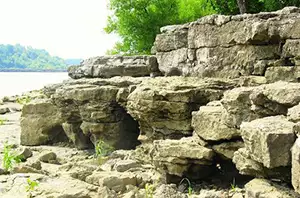
Devonian fossil beds on the Ohio River
In the southwestern continental United States, the plate of the Antler arc began to collide with the Cordilleran miogeocline. The exact nature of the event isn't known but one theory indicates passive margin deepwater deposits were thrust eastward over coeval carbonate shelf deposits to become the Roberts Mountain Allocthon (in the vicinity of what is now Battle Mountain in central Nevada). The Antler arc itself collided with partly rifted fragments off western North America. As the event went on well into the Carboniferous Period, the largest blocks of the Antler arc became the nucleus for the Quesnell and Stikine terranes which were accreted to Laurentia during the Mesozoic Age. The beginning of the Antler orogeny has been dated to coincide with the date of the Alamo bolide event.
About 367 million years ago, an extraterrestrial object (or objects) slammed into shallow marine waters in the area that is now southern Nevada. The event is named the Alamo bolide event, after the nearby town of Alamo. The impact was in the area of the Worthington Mountains and Schell Creek Range. The actual site of impact hasn't been located due to deformation of the surface over time and the presence of east-west faulting in the area. That east-west faulting has caused sections of the surface to separate laterally for miles and miles. What ties the remains of the impact site together are the displaced rocks, the elevated iridium levels, the shocked quartz and the spherical lapilli. The impact was several million years before the Frasnian/Fammenian Extinction Events.
There were several extinction pulses during the Devonian, mostly indicated today by changes in the marine fossil deposition record. At the boundary of the Frasnian and Fammenian stages was the Kellwasser Event, indicated today by two layers of black shale. There were several distinct extinction pulses prior to the Kellwasser Event but the Event itself marked the end of about 20 million years of ongoing mass extinction in the oceans. The Devonian ended with the Hangenburg Event, an extinction pulse that wiped out many marine and terrestrial species. The Hangenburg Event was comparable to the Cretaceous-Tertiary Extinction Event which wiped out the dinosaurs.
The survivors of the Hangenburg Event were significantly smaller in size and sizes remained small for the next 35 million years. The first 15 million years of the Carboniferous Period is also short on terrestrial animal fossils, a gap in the sequence known as Romer's Gap. Romer's Gap also correlates with a period of unusually low atmospheric oxygen. Prior to Romer's Gap were primitive terrestrial forests and highly diverse marine animals. After Romer's Gap came the more modern forests on land and ray-finned fish and sharks in the seas.
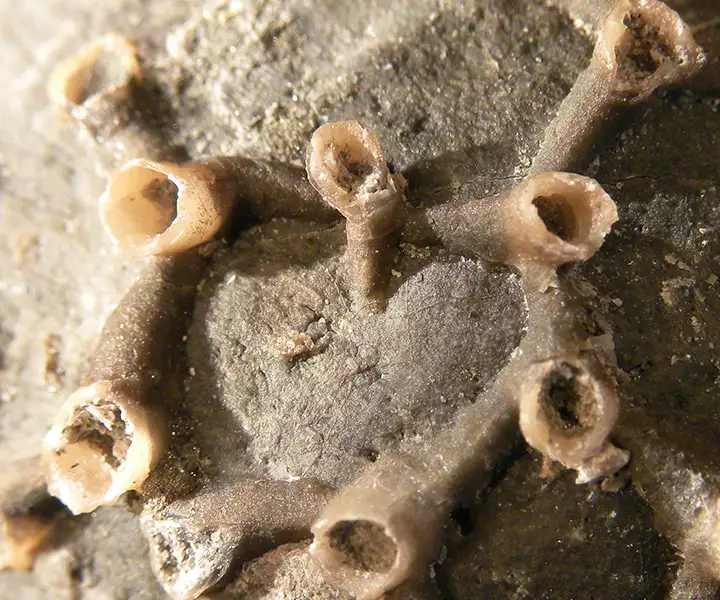
Aulopora, a tabulate coral from the Middle Devonian, fossilized in silica shale
Maps © Ron Blakey, NAU Geology, Deep Time Maps
Other photos are in the public domain
